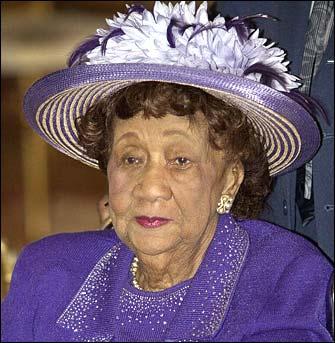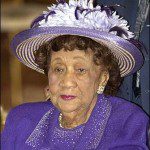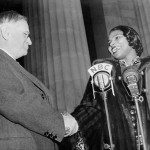As February comes to a cold, long end, with it ends the annual celebration, commemoration and acknowledgement that we call Black History Month, celebrated and noted in an especially strong and defining way in Washington, D.C.
Events throughout the month noted one aspect of black history or another — Frederick Douglass’ birthday and Abraham Lincoln’s birthday, because the two leaders are intertwined and wrapped up in the times of their time, the agony of the Civil War, the triumph of Emancipation. At Mount Vernon, there were commemorative services and wreath-layings for the slaves at the first president’s Virginia plantation.
The Smithsonian Black History Month Family Day Celebration will be held Feb. 27, rescheduled from an earlier day in the month and featuring the theme “Tapestry of Cultural Rhythms.” The idea of a black history month, first begun as far back as 1926 by historian Carter G. Woodson as “Negro History Week” before becoming what we know as Black History Month, remains strangely controversial. Some of this is, of course, due to the lingering feeling that the very existence of a black history month forces people to think about, and often actually talk about, race in America. In Washington, the longer you live here, the more the idea of Black History Month seems hardly novel at all, as natural as breathing. This city, in function, culture, politics, economics, identity and social structure, is so Sybil-like, schizoid, diverse, multi-faceted and multi-tasked that it resists a wholesale identity. It is the capital of the United States, politically and governmentally, but that doesn’t necessarily amount to an identity. The White House, Capitol Hill and Congress are hard-core presences of the city’s function. They are not its heart and soul.
That honor belongs to us: we the people that live here. If the city has a defining identity, in terms of history, the idea of black history has played itself out here from the beginning. How black and white residents have built, lived, worked, created a social and cultural environment here tells you an enormous amount about the history of race in America.
In this city, you don’t ask the question of whether there is a black history here, because you’re living it every day, and confront it, embrace it, see it in every neighborhood and ward of the city. One of the things you find, past the historic homes and buildings, past the large number of churches, many of them built from the ground up after emancipation by black pastors and ministers, is that black history is everybody’s history in this city, it is, as a young essay contest winner wrote, “American history.”
This is the city where in all the time of Jim Crow, local blacks, their number swollen by the great migration to northern cities in the first decades of the 20th century, created a thriving black community apart from all the places in the city where they could not shop, eat , hear music or go to school. Thus a large section of Washington, spurred by Howard University, had its own lawyers and doctors, its shops and shopkeepers and businesses, its culture.
While lots of major urban centers in America have large black populations, Washington is different because of its politics and structure. Until the 1970s, it had no self-rule of any sort, and even now has no voting rights in Congress. Its history of home rule is brief, only some 40 years or so.
Every street, and maybe every street corner, and certainly every neighborhood large and small, is a part of black history. Three of the major churches in Georgetown on or near P Street are reminders of a large black population that existed early in the century and thrived for decades before dispersing into the suburbs.
Walk the African Heritage Trail, a guide to the entire city’s heritage of black history, and you’ll discovery all of our history here, along with the rich contributions of African American civil rights leaders, educators, teachers, politicians, political leaders, athletes and artists. Memories of segregation and Jim Crow live in memory here.
In almost every ward and neighborhood of this city, you’ll find the strong presence of African American men and women who made history, who helped create institutions, movements and ideas that live on, who lived here, day in and day out, who created or were leaders in their communities.
Black history resounds in the homes, buildings, institutions and churches of Washington: at Howard University, at the Lincoln Theater and the True Reformer Building in Greater U Street, where Duke Ellington lived early in his life, at the African American Civil War Memorial and Museum at the old Howard Theater, the Black Fashion Museum and the Whitelaw Hotel, at the Supreme Court where Thurgood Marshall became a towering figure.
You can find it at the Mary McLeod Bethune Council House, the first headquarters of the National Council of Negro Women, which Bethune founded, and which is still led by the indomitable civil rights leader Dorothy Height, who in turned founded the Black Family Reunions held annually on the Mall and across the country. It lives in the Shiloh Baptist Church in Shaw, in the slave cemeteries in Georgetown, at the DAR Constitution Hall, where Marian Anderson was not allowed to sing by the DAR, and at the Lincoln Memorial. It’s in the Frederick Douglass National Historic City at 14th and W Streets SE, at Fort Stevens in Brightwood and at the Summer School Museum and Archives.
And all along the Heritage Trail, you’ll find the names and homes of familiar historic figures: Willis Richardson, Paul Dunbar, Anna Julia Cooper, Christian Fleetwood, Ernest Everett Just, Charles Manuel “Sweet Daddy” Grace, Alain Locke, Mary Jane Patterson Carter G. Woodson, Anthony Bowen, Benjamin Banneker, Howard Woodson, Lois Mailou Jones and many others.
The National Mall is where the Revered Martin Luther King gave his resounding “I Have a Dream” speech, which energized the entire country and fired up the imagination of generations to come. His assassination in 1968 sparked a full-scale war and deadly, destructive riots — known simply as “the riots” — the effects of which devastated the local economy for years to come. That too is black history.
All the changes — downtown development, the decline of black population, the rise of condoland, our loyalties to schools and sports — make up the common knowledge of living here. We all see this all of the time, yet, it’s fair to say, we — black and white — don’t know as much about each other and interact as much as we should, and certainly could. Race is an integral, if not integrated, part of this city, and black history is also a history of race in America. This is a city where, in one mayoral election consisting entirely of black candidates, one of them was designated by others as the “white candidate.” Major political, emotional and cultural discussions about crime and education inevitably have components of class and race to them.
But our city’s history is a shared one. It exists for all of us in memory, if we access it. It snows on everyone, on all the neighborhoods, even though some might fare better than others when it comes to snow removal. We are a string of connected neighborhoods, with a history that we all own and share. Whatever you might say about our transit system, it moves on tracks that criss-cross every part of the city and outside of it too.
All of us lead daily lives, and in this way, we are more closely connected to each other, like a family, than to any temporary residents in the White House, in Congress and on K Street.
- Dorothy Height







